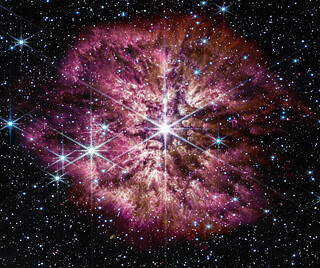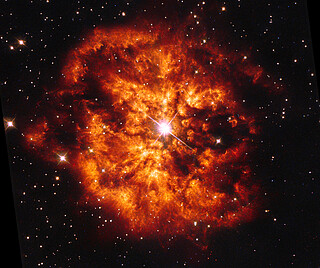Webb and Hubble showcase Wolf-Rayet 124 (Slider Tool)
A Wolf-Rayet star is a rare prelude to the famous final act of a massive star: the supernova. A distinctive halo of gas and dust frames the star, displaying knotty structure and a history of episodic ejections. Despite being the scene of an impending stellar ‘death’, astronomers also look to Wolf-Rayet stars for insights into new beginnings. Cosmic dust is forming in the turbulent nebulas surrounding these types of stars, which is composed of the heavy-element building blocks of the modern Universe, including life on Earth.
The image on the left is a composite image from the NASA/ESA/CSA James Webb Space Telescope combining near-infrared and mid-infrared wavelengths of light. The star displays the characteristic diffraction spikes of Webb’s Near-infrared Camera (NIRCam), caused by the physical structure of the telescope itself. NIRCam effectively balances the brightness of the star with the fainter gas and dust surrounding it, while Webb’s Mid-Infrared Instrument (MIRI) reveals the nebula’s structure.
The image on the right is an optical image from the NASA/ESA Hubble Space Telescope. The image was taken by Hubble’s Wide Field Planetary Camera 2 and was released by ESA/Hubble in 2015. The star shines brightly at the very centre of this explosive image and around the hot clumps of gas are ejected into space at over 150 000 kilometres per hour.
Credit:NASA, ESA, CSA, STScI, ESA/Hubble, Webb ERO Production Team
About the Images
| Id: | weic2307b | |
|---|---|---|
| Release date: | 14 March 2023, 19:00 | |
| Related releases: | weic2307 | |





